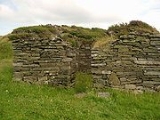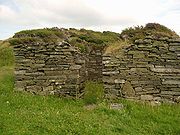
Eileach an Naoimh
Encyclopedia
Eileach an Naoimh, also known as Holy Isle, is an uninhabited island in the Inner Hebrides
of the west coast of Scotland
. It is the southernmost of the Garvellachs
archipelago and lies in Firth of Lorne
between Mull
and Argyll
. The name is Gaelic for "rocky place of the saint".
About 542
, St. Brendan the Navigator founded a monastery
on Eilach, presumed to be the island, possibly because of the combination of its isolation and good grazing. This may make the remains the oldest extant church buildings in Britain, although the earliest written record of its existence dates from the late 9th century. Columba
is believed to have visited the island and it is one of the proposed locations of the Columban retreat isle of Hinba
. Eileach an Naoimh may be the burial site of Columba's mother Eithne.
 The monastery was destroyed by - or, at least, may have become excessively vulnerable to - Viking
The monastery was destroyed by - or, at least, may have become excessively vulnerable to - Viking
raiders, from about 800
. The island has probably seen only intermittent occupation since, which has contributed to the survival of the ruins of many of the monastic buildings, including two chapels, beehive cells, and a graveyard with three crosses and another circular grave. The cells are contained in a pentagonal enclosure overlooking the rocky landing place on the south, which is guarded by various skerries
. Beyond the enclosure there is another cell with two rooms. The oldest chapel is rectangular and may date from the 11th or 12th centuries. The monastic ruins are the oldest ecclesiastical buildings in Scotland and the site is in the care of Historic Scotland
.
There is no ferry service, and transport to the island and its neighbours must be arranged privately.
Inner Hebrides
The Inner Hebrides is an archipelago off the west coast of Scotland, to the south east of the Outer Hebrides. Together these two island chains form the Hebrides, which enjoy a mild oceanic climate. There are 36 inhabited islands and a further 43 uninhabited Inner Hebrides with an area greater than...
of the west coast of Scotland
Scotland
Scotland is a country that is part of the United Kingdom. Occupying the northern third of the island of Great Britain, it shares a border with England to the south and is bounded by the North Sea to the east, the Atlantic Ocean to the north and west, and the North Channel and Irish Sea to the...
. It is the southernmost of the Garvellachs
Garvellachs
The Garvellachs or Isles of the Sea form a small archipelago in the Inner Hebrides of Scotland. Part of the Argyll and Bute council area, they lie west of Lunga and northwest of Scarba and have been uninhabited since World War II.The islands include Garbh Eileach, Dùn Channuill and Eileach an...
archipelago and lies in Firth of Lorne
Firth of Lorne
The Firth of Lorn is a body of water on Scotland's west coast, in Argyll and Bute. It lies between the Isle of Mull to the northwest and the Isles of Kerrera, Seil and Luing along with parts of the Scottish mainland southwest of Oban on the southeast side...
between Mull
Isle of Mull
The Isle of Mull or simply Mull is the second largest island of the Inner Hebrides, off the west coast of Scotland in the council area of Argyll and Bute....
and Argyll
Argyll
Argyll , archaically Argyle , is a region of western Scotland corresponding with most of the part of ancient Dál Riata that was located on the island of Great Britain, and in a historical context can be used to mean the entire western coast between the Mull of Kintyre and Cape Wrath...
. The name is Gaelic for "rocky place of the saint".
About 542
542
Year 542 was a common year starting on Wednesday of the Julian calendar. From this year forward, the appointment of particular Roman consuls was abandoned and the office was merged with that of Byzantine emperor...
, St. Brendan the Navigator founded a monastery
Monastery
Monastery denotes the building, or complex of buildings, that houses a room reserved for prayer as well as the domestic quarters and workplace of monastics, whether monks or nuns, and whether living in community or alone .Monasteries may vary greatly in size – a small dwelling accommodating only...
on Eilach, presumed to be the island, possibly because of the combination of its isolation and good grazing. This may make the remains the oldest extant church buildings in Britain, although the earliest written record of its existence dates from the late 9th century. Columba
Columba
Saint Columba —also known as Colum Cille , Colm Cille , Calum Cille and Kolban or Kolbjørn —was a Gaelic Irish missionary monk who propagated Christianity among the Picts during the Early Medieval Period...
is believed to have visited the island and it is one of the proposed locations of the Columban retreat isle of Hinba
Hinba
Hinba is an island in Scotland of unknown location that was the site of a small monastery associated with the Columban church on Iona. Although a number of details are known about the monastery and its early abbots, and various anecdotes dating from the time of Columba of a mystical nature have...
. Eileach an Naoimh may be the burial site of Columba's mother Eithne.

Viking
The term Viking is customarily used to refer to the Norse explorers, warriors, merchants, and pirates who raided, traded, explored and settled in wide areas of Europe, Asia and the North Atlantic islands from the late 8th to the mid-11th century.These Norsemen used their famed longships to...
raiders, from about 800
800
Year 800 was a leap year starting on Wednesday of the Julian calendar. It was around this time that the Anno Domini calendar era became the prevalent method in Europe for naming years, so from this time on, the years began being known as 800 and onwards.- Europe :* December 25 - Pope Leo III...
. The island has probably seen only intermittent occupation since, which has contributed to the survival of the ruins of many of the monastic buildings, including two chapels, beehive cells, and a graveyard with three crosses and another circular grave. The cells are contained in a pentagonal enclosure overlooking the rocky landing place on the south, which is guarded by various skerries
Skerry
A skerry is a small rocky island, usually defined to be too small for habitation. It may simply be a rocky reef. A skerry can also be called a low sea stack....
. Beyond the enclosure there is another cell with two rooms. The oldest chapel is rectangular and may date from the 11th or 12th centuries. The monastic ruins are the oldest ecclesiastical buildings in Scotland and the site is in the care of Historic Scotland
Historic Scotland
Historic Scotland is an executive agency of the Scottish Government, responsible for historic monuments in Scotland.-Role:As its website states:...
.
There is no ferry service, and transport to the island and its neighbours must be arranged privately.

